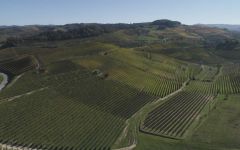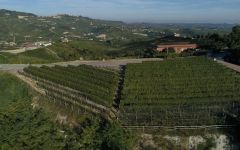Arnaldo Rivera Barolo Undicicomuni 2016
-
James
Suckling -
Robert
Parker -
Wilfred
Wong - Decanter



Product Details
Your Rating
Somm Note
Winemaker Notes
Barolo Undicicomuni is arguably Arnaldo Rivera’s most important wine. Spiced cedar, leather, and scorched earth on the nose. The palate is wild and savory with notes of crushed raspberry, figs, cinnamon, star anise alongside velvety dusty tannins and fresh acidity. It stylish meaty and delicious and super uber Nebbiolo cool. Blending fruit from across the Langhe eleven Barolo villages, it epitomizes the quintessential values of traditional, historic Barolo. While the Arnaldo Rivera single vineyard Barolos are stunning, it is the Barolo Undicicomuni that demands the winemaker greatest attention. He is required to blend different fruit and terroir expressions from diverse villages, just as an artist balances colors to complete his work of art. This means that the Barolo Undicicomuni is naturally Arnaldo Rivera most complex Barolo. A shorter ageing in wood, instead of the 32 months of each cru, allows the wine to be more accessible and suitable for early drinking. A consistently great example of Barolo.
Professional Ratings
-
James Suckling
Aromas of sweet berries with fresh, floral and forest-flower notes that turn to conifer and perfume. Medium-to full-bodied with racy tannins. I like the dried-fruit flavors with hints of mushrooms and dried meat. Better in 2022.
-
Robert Parker's Wine Advocate
This wine takes the record for the most complicated blend made with the largest number of vineyard sites. The Arnaldo Rivera 2016 Barolo Undicicomuni draws its fruit from 10 vineyards spanning the appellation, and I know of no other winery that has attempted such an ambitious assembly of Nebbiolo. For the record, the blend (starting in 2013 until the 2017 vintage) is Serralunga d'Alba (San Rocco); Castiglione Falletto (Codana, Piantà and Villero); Diano d'Alba (two sites in Sorano); La Morra (Boiolo and two sites in Rocche dell'Annunziata); and Verduno (Campasso). From the 2018 vintage onward, the blend is made from a whopping 21 parcels. The watercolor design on the label depicts the shape of these vineyard sites. This super blend showcases the depth and the tannic firmness of the grape with bold fruit aromas backed by tar, licorice and earthy truffle. I'd dedicate a few more years of cellar aging in order to soften those tannins. An ample 50,000 bottles will be released in September 2020.
-
Wilfred Wong of Wine.com
COMMENTARY: The 2016 Arnaldo Rivera Undicicomuni Barolo is compelling and lasting on the palate. TASTING NOTES: This wine excels with aromas and flavors of dried earth, bright cherries, savory spices, and dusty earth. Pair it with grilled beef. (Tasted: November 21, 2022, San Francisco, CA)
-
Decanter
Though Terre di Barolo’s ArnaldoRivera label focuses on cru bottlings, Undicicomuni combines fruit from all 11 Barolo communes. Upfront cherry and cinnamon meet chocolate and hazelnut notes redolent of the Langhe’s landscape. The palate is supple and approachable yet youthful, with tannins piling up toward the finish. There is enough stuffing to balance and the finish is clean and bright. A polished, friendly ambassador for the region.
Other Vintages
2017-
James
Suckling -
Wine
Spectator -
Robert
Parker -
Jeb
Dunnuck -
Wine
Enthusiast
-
Wine
Spectator -
James
Suckling
-
James
Suckling





Arnaldo Rivera wines are the result of a partnership between Terre del Barolo winery and a number of its growers with the aim of producing the region’s best grapes and wines. The vineyards of origin are among the most prestigious on the Langhe hills. They are ultimate expression of expertise and craftsmanship, where the purity of the single varietal is at the absolute pinnacle, testifying to the unmistakable identity of Piedmont’s wines. This label is a unique, new journey through the eleven villages and native varietals in the Barolo winegrowing area, from the vineyard management, to the vinification techniques and woods used; it is truly the wines and the land they come from that speak for themselves.
Arnaldo Rivera was born on December 13th, 1919 in Castiglione Falletto, a small village at the heart of the historic Barolo winegrowing area. He was a local primary school teacher, mayor of his village for 36 years, and founder in 1958 of the Terre del Barolo winery. He lived through the hard times of the war in the front line, as well as the days of the liberation. He and his wife Ester Rinaldi were not blessed with children. Arnaldo Rivera passed away on January 10th, 1987. This project was created by the growers and the winery in honor of this great man.

Responsible for some of the most elegant and age-worthy wines in the world, Nebbiolo, named for the ubiquitous autumnal fog (called nebbia in Italian), is the star variety of northern Italy’s Piedmont region. Grown throughout the area, as well as in the neighboring Valle d’Aosta and Valtellina, it reaches its highest potential in the Piedmontese villages of Barolo, Barbaresco and Roero. Outside of Italy, growers are still very much in the experimentation stage but some success has been achieved in parts of California. Somm Secret—If you’re new to Nebbiolo, start with a charming, wallet-friendly, early-drinking Langhe Nebbiolo or Nebbiolo d'Alba.

The center of the production of the world’s most exclusive and age-worthy red wines made from Nebbiolo, the Barolo wine region includes five core townships: La Morra, Monforte d’Alba, Serralunga d’Alba, Castiglione Falletto and the Barolo village itself, as well as a few outlying villages. The landscape of Barolo, characterized by prominent and castle-topped hills, is full of history and romance centered on the Nebbiolo grape. Its wines, with the signature “tar and roses” aromas, have a deceptively light garnet color but full presence on the palate and plenty of tannins and acidity. In a well-made Barolo wine, one can expect to find complexity and good evolution with notes of, for example, strawberry, cherry, plum, leather, truffle, anise, fresh and dried herbs, tobacco and violets.
There are two predominant soil types here, which distinguish Barolo from the lesser surrounding areas. Compact and fertile Tortonian sandy marls define the vineyards farthest west and at higher elevations. Typically the Barolo wines coming from this side, from La Morra and Barolo, can be approachable relatively early on in their evolution and represent the “feminine” side of Barolo, often closer in style to Barbaresco with elegant perfume and fresh fruit.
On the eastern side of the Barolo wine region, Helvetian soils of compressed sandstone and chalks are less fertile, producing wines with intense body, power and structured tannins. This more “masculine” style comes from Monforte d’Alba and Serralunga d’Alba. The township of Castiglione Falletto covers a spine with both soil types.
The best Barolo wines need 10-15 years before they are ready to drink, and can further age for several decades.
